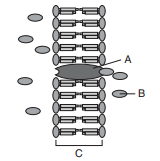1.Find out the total number of false statements from the following.
(1) The diffusion rate depends on the size of substrate.
(2) Diffusion across membrane depends upon the solubility of lipids.
(3) Membrane protein provide sites for hydrophilic substance to cross membrane.
(4) Facilitated diffusion do not require concentration gradient.
a) 1
b) 2
c) 3
d) 4
Explanation: Only 1
2. Facilitated diffusion requires _________ to transport substance across membrane.
a) Special membrane protein
b) ATP
c) Protein inhibitor
d) All of these
Explanation: Facilitated diffusion requires special membrane protein to transport substance across membrane.
3. Which process undergoes saturation?
a) Facilitated diffusion
b) Active transport
c) Simple diffusion
d) Both (a) and (b)
Explanation: Both (a) and (b)
4. Which of the following transport is not highly selective?
a) Facilitated diffusion
b) Active transport
c) Simple diffusion
d) All of these
Explanation: Simple diffusion
5. Identify A, B and C in the given figure.
a) A–Transported molecule, B–Inner side of cell, C–Transport protein
b) A–Transport protein, B–Transported molecule, C–Membrane
c) A–Inner side of cell, B–Membrane, C–Transported molecule
d) A–Membrane, B–Transport protein, C–Transported molecule
Explanation: A–Transport protein, B–Transported molecule, C–Membrane
6. Where are poring proteins present?
a) Outer membrane of plastid
b) Inner membrane of mitochondria
c) Inner membrane of some bacteria
d) Outer membrane of ribosomes
Explanation: Outer membrane of plastid
7. Choose the total number of correct statements from the following:
(1) Some channels in membrane are always open.
(2) Porins allow the passage of molecule of size up to small protein.
(3) Water channel made up of eight different type of aquaporins.
(4) Facilitated diffusion is very specific.
a) 1
b) 2
c) 3
d) 4
Explanation: 4
8. Some transport proteins allow diffusion only. If two type of molecules move together in the
same direction. Such type of transport is known as
a) Symport
b) Antiport
c) Uniport
d) All of these
Explanation: Some transport proteins allow diffusion only. If two type of molecules move together in the same direction. Such type of transport is known as Symport.
9. If two type of molecules move together in opposite direction. Such type of transport is known
as
a) Symport
b) Antiport
c) Uniport
d) All of these
Explanation: If two type of molecules move together in opposite direction. Such type of transport is known as Antiport.
10. When the molecule move across in a membrane independent of other molecules through carrier protein the process is known as
a) Symport
b) Antiport
c) Uniport
d) All of these
Explanation: When the molecule move across in a membrane independent of other molecules through carrier protein the process is known as Uniport.